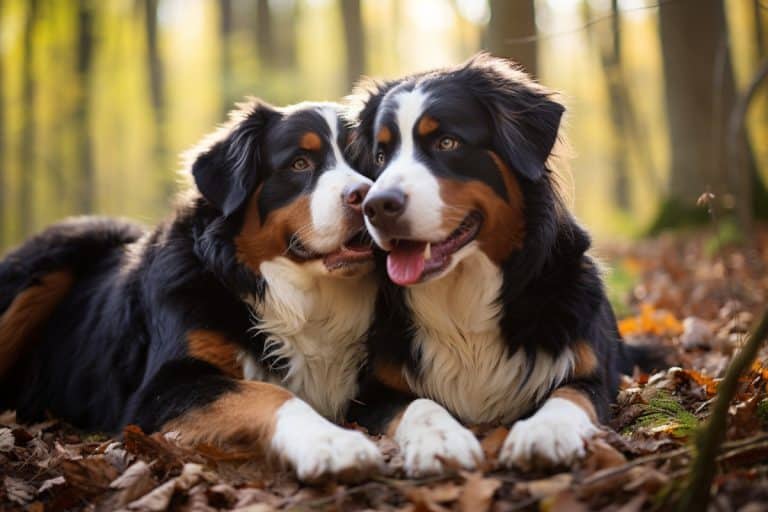Bernese Mountain Dogs are big, lovable companions with a lot of hair and even more heart. If you’re lucky enough to have one of these gentle giants as a part of your family, it’s crucial to know about their heat cycle. It’s a natural part of a dog’s life, and understanding it is part of being a responsible pet owner. So, let’s dive into the world of Bernese Mountain Dog’s heat cycle to learn what to expect and how to care for your furry friend during this time.
Understanding the Bernese Mountain Dog’s Heat Cycle
The heat cycle, also known as estrus, is a time when female dogs can get pregnant. It’s how Mother Nature says, “Hey, it’s baby time!” It’s a bit like how human women have a monthly cycle, but for dogs, it happens only once or twice a year.
Each dog breed is a bit different, and the Bernese Mountain Dog is no exception. These dogs have a heat cycle that can be influenced by their size, health, and living conditions. Now, let’s explore the frequency and duration of the Bernese Mountain Dog’s heat cycle.
How Often Do Bernese Mountain Dogs Go Into Heat?
Bernese Mountain Dogs usually go into heat about once or twice a year. It’s less frequent compared to smaller breeds that might have three or four cycles a year. The timing can also change as your dog ages or if they have health issues.
Keeping track of your dog’s heat cycles can help you plan. For instance, if you’re not looking to expand your furry family, knowing the cycle helps in preventing unwanted pregnancies. Also, a regular cycle means your dog is healthy.
How Long Is a Bernese Mountain Dog in Heat?
When your Bernese Mountain Dog goes into heat, it usually lasts for about two to four weeks. During this time, you’ll notice several stages. The first stage is called Proestrus which lasts about 9 days. Your dog won’t be ready for mating yet, but she’ll attract male dogs. The second stage is Estrus where she is receptive to males, and this lasts for about 9 days too. After that comes the Diestrus stage which lasts until the next cycle begins.
Understanding these stages helps to manage your dog’s behavior and health better. It also helps you to provide the right care and attention during these delicate times.
When to Neuter a Bernese Mountain Dog
Deciding when to neuter your Bernese Mountain Dog is a big decision. Neutering is a procedure that stops your dog from being able to have puppies. Many vets recommend waiting until your dog is about 1 to 2 years old (12 to 24 months) before neutering. This wait allows your dog to fully grow and develop before undergoing the procedure.
Neutering can also help prevent certain health issues and behaviors related to the heat cycle. So, it’s not just about preventing puppies, it’s about keeping your dog healthy too.
Signs Your Bernese Mountain Dog Is In Heat
You might wonder how you’ll know when your dog is in heat. Well, there are signs to look for. Your dog may act differently, like being more cuddly or more grumpy. You might also notice some physical signs like a swollen area or a small amount of blood.
It’s essential to give extra care and attention during this time. Keeping your dog comfortable and reducing stress will help both you and your dog navigate through the heat cycle smoothly.
How to Properly Care for Bernese Mountain Dogs During Heat
Bernese Mountain Dogs are a breed full of love, warmth, and loyalty. They deserve the best care, especially during their heat cycles. This period can be a bit challenging not just for your dog, but also for you. However, with a bit of knowledge and preparation, you can provide the necessary care and comfort your dog needs during this time. Here are some helpful tips and steps to follow to ensure your Bernese Mountain Dog remains healthy and comfortable during their heat cycle.
Recognize the Signs of Heat
Before you can provide the proper care, you need to know when your dog is in heat. Some common signs include:
- Swelling of the vulva
- A small amount of bloody discharge
- Increased urination
- Behavioral changes like being more affectionate or, conversely, more grumpy
Keep Your Dog Comfortable
During heat, your Bernese Mountain Dog might feel a bit out of sorts. Here’s what you can do to keep her comfortable:
- Provide a cozy and quiet space for her to relax.
- Ensure she has a comfortable bed or blanket to lie on.
Maintain a Clean Environment
Keeping your dog and her environment clean is crucial during this time to prevent infections.
- Wipe her vulva gently with warm water and mild soap.
- Clean her bedding regularly.
Provide Extra Attention and Exercise
Your Bernese Mountain Dog may require more attention and exercise to help manage stress and excess energy.
- Keep up with her regular exercise routine.
- Spend extra time playing and bonding with her.
Consult With Your Veterinarian
It’s always a wise idea to consult with your vet during this stage.
- Your vet might suggest a special diet to keep your dog healthy.
- They can also provide advice on managing any behavioral issues that arise.
Avoid Unwanted Pregnancies
If you’re not looking to have puppies, it’s essential to prevent mating.
- Keep your dog on a leash and supervise her while she’s outside.
- Avoid areas with unleashed male dogs.
Monitor Her Health
Keep a close eye on your dog’s health.
- Check for signs of discomfort or infection.
- Have a vet checkup to ensure everything is progressing normally.
Consider Neutering
If you decide not to breed your Bernese Mountain Dog, you might want to consider neutering as a long-term solution to avoid the challenges of the heat cycle. Discuss with your vet the right time to perform this procedure.
Conclusion
Being knowledgeable about your Bernese Mountain Dog’s heat cycle is part of being a caring and responsible pet owner. Understanding the signs, frequency, and the right time for neutering are crucial steps to ensuring a happy and healthy life for your furry companion. Your journey through the heat cycle might have its challenges, but with the right information and support from your vet, you and your Bernese Mountain Dog can navigate through it with ease.








